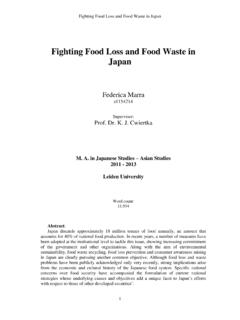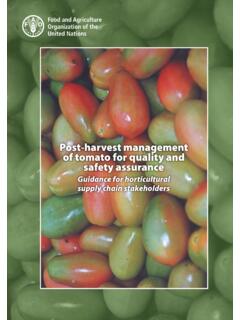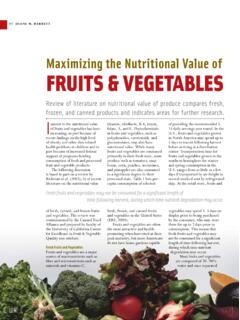Transcription of FARM DESIGN FOR COMMERCIAL BUTTON MUSHROOM …
1 Farm DESIGN for COMMERCIAL BUTTON MUSHROOM Cultivation Contents Introduction Farm DESIGN for Environmental controlled cropping o Selection of site and pre-requisites o Components of a MUSHROOM farm o Spawn unit o Composting Unit o Post harvest handling unit o Cropping unit o General Layout/Location of various Units Farm DESIGN for seasonal cultivation o Composting yard/ space o Cropping rooms Machinery required Introduction White BUTTON MUSHROOM is a temperate MUSHROOM requiring cooler climate for its growth. It is an indoor crop and is an ideal tool in converting agricultural wastes in to protenaceous food. In early days its cultivation was mainly confined to the hills. In the eighties growers realized the potential of this crop and started its cultivation in the northern plains in the winter when the climate was suitable for its growth. Many entrepreneurs in the plains further ventured and startedits cultivation round the year by employing artificial cooling facilities (chilling stations).
2 Today its cultivation is done in across the country. Some are doing it seasonally while many of them have preferred to go in for round the year cultivation. Today India boasts of having world s biggest farm, the Agro Dutch Foods Ltd, Lalru Punjab and many more such environment controlled units exit in different parts of the country cultivating this MUSHROOM round the year. MUSHROOM being an indoor crop does not require arable land, except for some non- agricultural land to build the infrastructure for preparation of substrate, raising of crop, preparation of spawn and postharvest handling. As mentioned above this MUSHROOM is grown seasonally and in environment controlled cropping houses and both require building of basic infrastructure. Seasonal growing is done for 3-4 months when outside temperatures are favourable for the crop, , during winter months in plains and from September to April in the hills.
3 Seasonal cultivators of this MUSHROOM are mainly using traditional methods of its cultivation and are mainly cultivating this MUSHROOM in the thatched structures employing long method of composting. They usually take single crop in the entire season and are normally harvesting 12- 15kg mushrooms/ 100 kg compost. Environment controlled units are cultivating this MUSHROOM round the year by having suitable infrastructure at their disposal which includes a modem composting yard having bulk pasteurization facilities. Of late few of them have shifted to indoor composting while new upcoming units have chosen to produce their compost entirely by indoor method. Besides these facilities they are having insulated cropping rooms and other ancillary structures required for MUSHROOM cultivation. Few of the bigger units are having their own spawn lab and processing unit as well.
4 An entrepreneur can start MUSHROOM cultivation modestly using seasonal growing houses and after gaining sufficient experience can shift to round the year cultivation employing suitable climate control facilities. Suitable infrastructure including different machineries arc required at the farm to carry out different operations to govern the whole process of cultivation in such a fashion so that one gets optimum returns from his farm in this competitive environment. The one who designs the farm in most scientific manner looking to the need of the crop and easy accessibility to the different infrastructure for their operation convenience in less space, utilizing less money will gain handsome returns in the years to come. Present chapter would deal in detail the infrastructure and machineries required for the seasonal and environment controlled units.
5 A. Farm DESIGN for Environmental controlled cropping I. Selection of site and pre-requisites Before selection of site, the following points have to be taken into consideration for greater operational efficiency and cost effective production of mushrooms at the farm: Chosen site should preferably be away from the municipal limits and entrepreneur should purchase sufficient land in one go looking to the future expansion. The site should be serviced by a motorable road, or nearer to a road head to reduce costs on transportation of raw materials to the farm/finished product to the market. Plentiful availability of water at the site either through a perennial source or should have sufficient underground water. Easy availability of raw materials especially straw and poultry manure around the chosen site at cheaper costs in the area.
6 Availability of cheap labour in abundance. Uninterrupted Proper power supply at the chosen site. Nearness to the market for the proper disposal of the produce. II. Components of a MUSHROOM farm For round the year cultivation of this MUSHROOM employing environment-controlled conditions a medium size plant would require under mentioned components. A. Spawn unit For producing in-house spawn for self requirement and for sale to other units. This will have under mentioned major components. 1. Cooking/autoclaving room: For boiling the grains and sterilization of the bottles/pp bags 2. Inoculation room: For inoculation of the sterilized bottles/ pp bags 3. Incubation room: For incubating the inoculated bottles. Insulated and provided with AC. 4. Cold Store: For storage of prepared spawn for its further disposal Besides above some ancillary structures like office, small lab space, delivery area, etc.
7 May also be required. Machineries required: Air conditioners, Laminar flow system, Autoclaves, BOD incubators, Boiler, Boling cattles, Refrigerators, racks, pH meter, gas stoves, etc. B. Composting Unit This will have under mentioned main components for production of compost 1. Pre wetting area: For dumping of raw materials and their pre wetting (uncovered). 2. Composting yard: For making piles out of the wetted materials (covered) 3. Phase-I bunker: For phase -I phase of composting (incase indoor composting is employed). 4. Phase -II tunnels: For performing pasteurization and conditioning of the compost. 5. Casing soil chambers: For pasteurization of the casing soil. 6. Spawning area: For spawning of the prepared compost Besides above certain ancillary rooms like boiler room, underground service room, store room, workers room etc. would also be required.
8 Machineries viz., boiler, blowers, air handling units, gratings, digital thermometers, compost retaining boards, ventilation system for phase -I bunkers would be required by a medium size farm (up to 200 TPA). Large farm besides above may require a front end loader (Bob cat) and other compost handling equipments including turner, filling line etc. C. Cropping unit A cropping unit will have series of insulted rooms of designated size depending up on the production targets. Besides rooms there will be AC/ compressor room, packing room, central corridor housing air handling units and pipelines. Machineries required: Insulted doors, central chilling station (ammonia or freon based), air handling units, computer based controllers (optional), racks, and trolleys, harvesting trays, etc. would also be required. For continuous electric supply to phase-I, phase- II tunnels and cropping rooms, generators of desired capacity would also be required.
9 D. Post harvest handling unit It will have under mentioned components: 1. Pre-cooling chamber (cold room): For storing the mushrooms before canning 2. Canning hall: For housing the canning line for processing 3. Laboratory: For quality control of processing 4. Store: For housing the processed can 5. Office: For sitting of the staff 6. Machinery required: Canning line of desired capacity ( details in chapter 22) E. General Layout/Location of various Units The layout is so planned that all the infrastructures required to be built are accommodated in least possible land without over looking MUSHROOM cultivation requirements. The general layout of a MUSHROOM farm has to be carefully planned after selection of the site, keeping in view the several factors including accessibility of road to the composting yard as raw materials are to be dumped here for their processing to the compost. Wind direction is also kept in mind for choosing the location of the composting facilities.
10 During most of the time of the year wind should flow from cropping area to the compost yard and not vice versa. Phase one bunkers are constructed inline nearer to the phase -II tunnels for their operational convenience and also to avoid heat losses . The bulk chambers are built nearer to the phase -I bunkers. Both these structures are preferably built away form the road at the distant end of the yard so that the distant end of the phase -II tunnels open nearer to cropping rooms and away from composting yard ( ). The cropping rooms are built away from composting area for reasons of cleanliness and avoiding contamination by pests and pathogens. The casing pasteurization chamber is built nearer to the composting yard or within the composting yard with small platform for preparing the casing soil (Fig. l). Enough space for future expansion of composting yard, construction of more phases-I & II chambers and growing rooms should be left vacant for planned development of a MUSHROOM farm in a phased manner.



